Strengths and Weaknesses of the UK and Indian Education Systems
VerifiedAdded on 2023/04/20
|12
|3074
|172
AI Summary
This essay discusses the strengths and weaknesses of the education systems in the UK and India, focusing on the impact on international students. It explores the advantages and disadvantages of studying in the UK, as well as the recent developments in the Indian higher education system. Recommendations for improving the education systems are also provided.
Contribute Materials
Your contribution can guide someone’s learning journey. Share your
documents today.
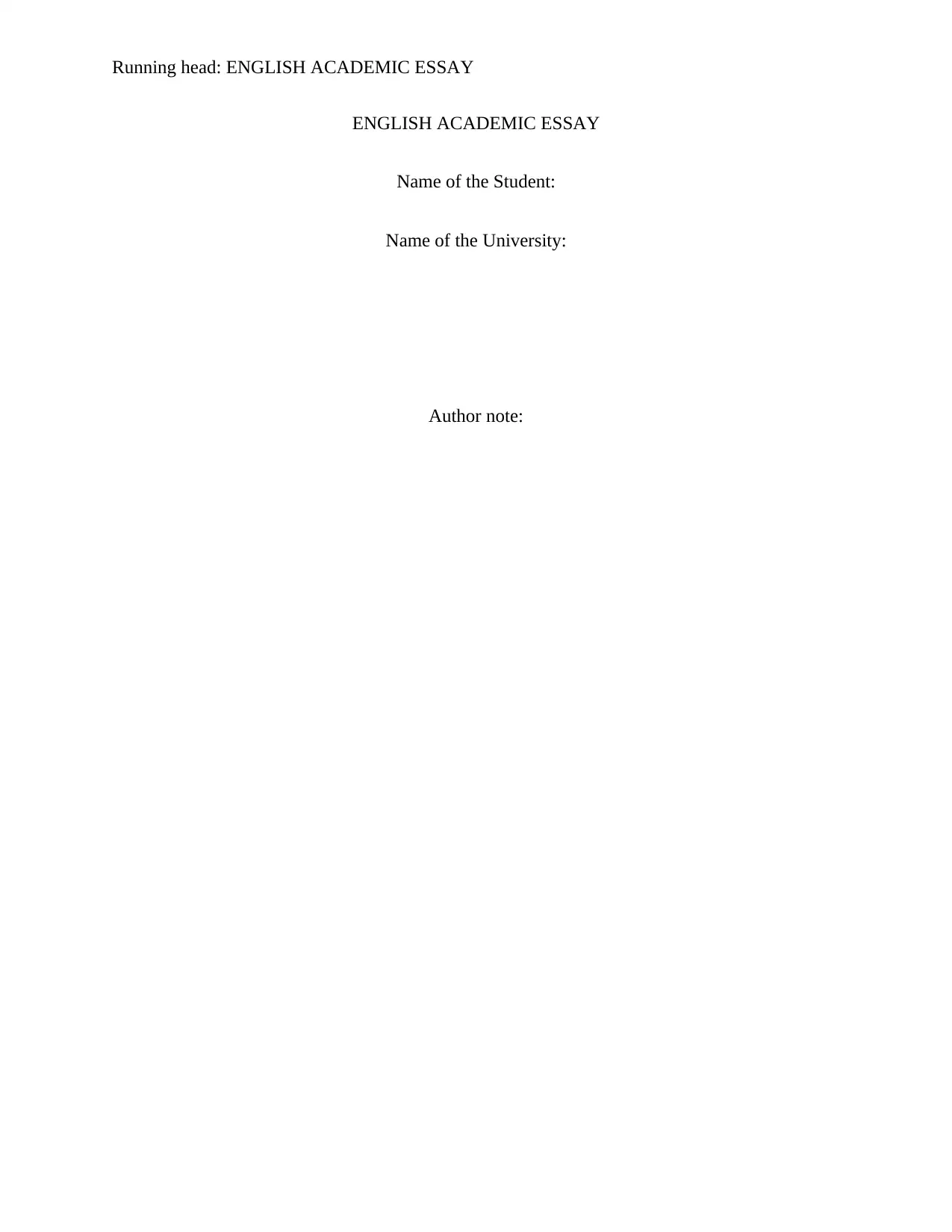
Running head: ENGLISH ACADEMIC ESSAY
ENGLISH ACADEMIC ESSAY
Name of the Student:
Name of the University:
Author note:
ENGLISH ACADEMIC ESSAY
Name of the Student:
Name of the University:
Author note:
Secure Best Marks with AI Grader
Need help grading? Try our AI Grader for instant feedback on your assignments.
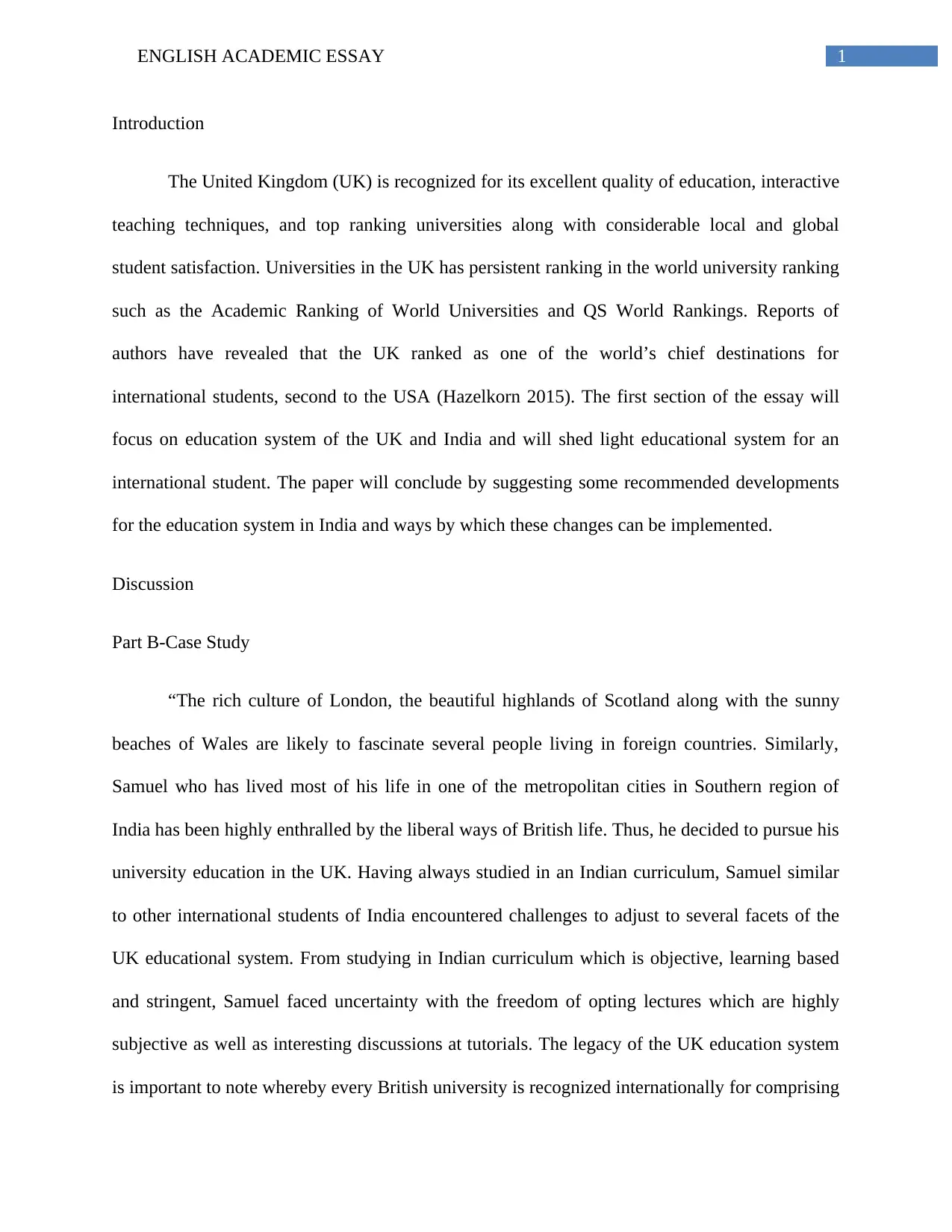
1ENGLISH ACADEMIC ESSAY
Introduction
The United Kingdom (UK) is recognized for its excellent quality of education, interactive
teaching techniques, and top ranking universities along with considerable local and global
student satisfaction. Universities in the UK has persistent ranking in the world university ranking
such as the Academic Ranking of World Universities and QS World Rankings. Reports of
authors have revealed that the UK ranked as one of the world’s chief destinations for
international students, second to the USA (Hazelkorn 2015). The first section of the essay will
focus on education system of the UK and India and will shed light educational system for an
international student. The paper will conclude by suggesting some recommended developments
for the education system in India and ways by which these changes can be implemented.
Discussion
Part B-Case Study
“The rich culture of London, the beautiful highlands of Scotland along with the sunny
beaches of Wales are likely to fascinate several people living in foreign countries. Similarly,
Samuel who has lived most of his life in one of the metropolitan cities in Southern region of
India has been highly enthralled by the liberal ways of British life. Thus, he decided to pursue his
university education in the UK. Having always studied in an Indian curriculum, Samuel similar
to other international students of India encountered challenges to adjust to several facets of the
UK educational system. From studying in Indian curriculum which is objective, learning based
and stringent, Samuel faced uncertainty with the freedom of opting lectures which are highly
subjective as well as interesting discussions at tutorials. The legacy of the UK education system
is important to note whereby every British university is recognized internationally for comprising
Introduction
The United Kingdom (UK) is recognized for its excellent quality of education, interactive
teaching techniques, and top ranking universities along with considerable local and global
student satisfaction. Universities in the UK has persistent ranking in the world university ranking
such as the Academic Ranking of World Universities and QS World Rankings. Reports of
authors have revealed that the UK ranked as one of the world’s chief destinations for
international students, second to the USA (Hazelkorn 2015). The first section of the essay will
focus on education system of the UK and India and will shed light educational system for an
international student. The paper will conclude by suggesting some recommended developments
for the education system in India and ways by which these changes can be implemented.
Discussion
Part B-Case Study
“The rich culture of London, the beautiful highlands of Scotland along with the sunny
beaches of Wales are likely to fascinate several people living in foreign countries. Similarly,
Samuel who has lived most of his life in one of the metropolitan cities in Southern region of
India has been highly enthralled by the liberal ways of British life. Thus, he decided to pursue his
university education in the UK. Having always studied in an Indian curriculum, Samuel similar
to other international students of India encountered challenges to adjust to several facets of the
UK educational system. From studying in Indian curriculum which is objective, learning based
and stringent, Samuel faced uncertainty with the freedom of opting lectures which are highly
subjective as well as interesting discussions at tutorials. The legacy of the UK education system
is important to note whereby every British university is recognized internationally for comprising

2ENGLISH ACADEMIC ESSAY
creative and exigent environments that facilitate international students to stimulatingly advance
to the extent of the course. Through the thought provoking discussions in classes and
extraordinarily high standards, Samuel has realized that all the UK universities are tested for
their ability of accomplishing continual modern challenges. The enhanced learning experiences
obtained by Samuel and other international students while studying in the UK has aided them to
obtain skills and competencies desired by them. Samuel has been encouraged to read, think
independently, pose queries and strategically analyse their curriculum and edification offered to
them through the stimulating modules.
However, despite all these benefits of the UK educational system, Samuel has faced
challenges of deciding on curriculum courses. An education in the UK will require that
international students to know accurately about the courses and its curriculum. This is the
contrary of Indian university curriculum that can change their major subjects around two to four
times during university and not be affected by it. However, despite the fact that there are certain
disadvantages for studying in the UK, it’s also undoubtedly worth it. A degree which Indian
students will be obtaining after pursuing their courses will be acknowledged as well as
appreciated in the whole world.”
Part B1
This section of the essay will review the areas of strengths and weaknesses of the UK
educational system and its influence on international students.
Advantages- International students are of significant importance to the UK educational sector
and the country more extensively (McCaffery 2018). Not only does the presence of international
students international enhances the academic environment as well as campus life of the UK, but
creative and exigent environments that facilitate international students to stimulatingly advance
to the extent of the course. Through the thought provoking discussions in classes and
extraordinarily high standards, Samuel has realized that all the UK universities are tested for
their ability of accomplishing continual modern challenges. The enhanced learning experiences
obtained by Samuel and other international students while studying in the UK has aided them to
obtain skills and competencies desired by them. Samuel has been encouraged to read, think
independently, pose queries and strategically analyse their curriculum and edification offered to
them through the stimulating modules.
However, despite all these benefits of the UK educational system, Samuel has faced
challenges of deciding on curriculum courses. An education in the UK will require that
international students to know accurately about the courses and its curriculum. This is the
contrary of Indian university curriculum that can change their major subjects around two to four
times during university and not be affected by it. However, despite the fact that there are certain
disadvantages for studying in the UK, it’s also undoubtedly worth it. A degree which Indian
students will be obtaining after pursuing their courses will be acknowledged as well as
appreciated in the whole world.”
Part B1
This section of the essay will review the areas of strengths and weaknesses of the UK
educational system and its influence on international students.
Advantages- International students are of significant importance to the UK educational sector
and the country more extensively (McCaffery 2018). Not only does the presence of international
students international enhances the academic environment as well as campus life of the UK, but

3ENGLISH ACADEMIC ESSAY
also tends to contribute over £7.5 billion to the UK economy. The cost of education for an
international student coming from Asian countries in the UK is likely to be lower in comparison
to other developed countries such as USA. Reports of Ally and Prieto-Blázquez (2014) have
revealed that majority of UK higher education institutions typically cost around £ 6000 to £ 7500
per year which is considered to be lower than USA. Adomßent et al. (2014) have noted that
although international students can supervise their office in order to condense the education
expenses UK policymakers have been considering the alarming shift in the cost of education for
the non-EU students. With the increasing elevation of exchange rates the UK education policy
makers have been efficiently working on the increasing expenses of international education.
According to Marginson (2016) as global competition for international students have been highly
intensifying several UK universities have been acting aggressively in order to sustain the UK as
a chief destination for international students.
Furthermore comprehensive studies of Beine, Noël and Ragot (2014) have highlighted
the strong research infrastructure of the UK educational system in which the country has been
contributing over 7.3% of international journal articles, 12.1% of citations in addition to around
16.2% of the worlds highly cited articles, although it comprises a minimal rate of 10% of the
world’s total population. Moreover, significant numbers of over 95,000 resources doctoral
degrees have been recognised in the country from 2009-2010 to 2014-2016. Hopkins et al.
(2014) have noted that the fields of chemical sciences, social sciences, language, business as well
as humanities tend to contribute strong emphasis in the research field of UK educational systems.
Meanwhile reports of Murray and Pérez (2014) have mentioned about the significant
changes which have been developed on the post study work visa since 2015. International
students coming from India currently have the authority to stay in the country after completing
also tends to contribute over £7.5 billion to the UK economy. The cost of education for an
international student coming from Asian countries in the UK is likely to be lower in comparison
to other developed countries such as USA. Reports of Ally and Prieto-Blázquez (2014) have
revealed that majority of UK higher education institutions typically cost around £ 6000 to £ 7500
per year which is considered to be lower than USA. Adomßent et al. (2014) have noted that
although international students can supervise their office in order to condense the education
expenses UK policymakers have been considering the alarming shift in the cost of education for
the non-EU students. With the increasing elevation of exchange rates the UK education policy
makers have been efficiently working on the increasing expenses of international education.
According to Marginson (2016) as global competition for international students have been highly
intensifying several UK universities have been acting aggressively in order to sustain the UK as
a chief destination for international students.
Furthermore comprehensive studies of Beine, Noël and Ragot (2014) have highlighted
the strong research infrastructure of the UK educational system in which the country has been
contributing over 7.3% of international journal articles, 12.1% of citations in addition to around
16.2% of the worlds highly cited articles, although it comprises a minimal rate of 10% of the
world’s total population. Moreover, significant numbers of over 95,000 resources doctoral
degrees have been recognised in the country from 2009-2010 to 2014-2016. Hopkins et al.
(2014) have noted that the fields of chemical sciences, social sciences, language, business as well
as humanities tend to contribute strong emphasis in the research field of UK educational systems.
Meanwhile reports of Murray and Pérez (2014) have mentioned about the significant
changes which have been developed on the post study work visa since 2015. International
students coming from India currently have the authority to stay in the country after completing
Secure Best Marks with AI Grader
Need help grading? Try our AI Grader for instant feedback on your assignments.
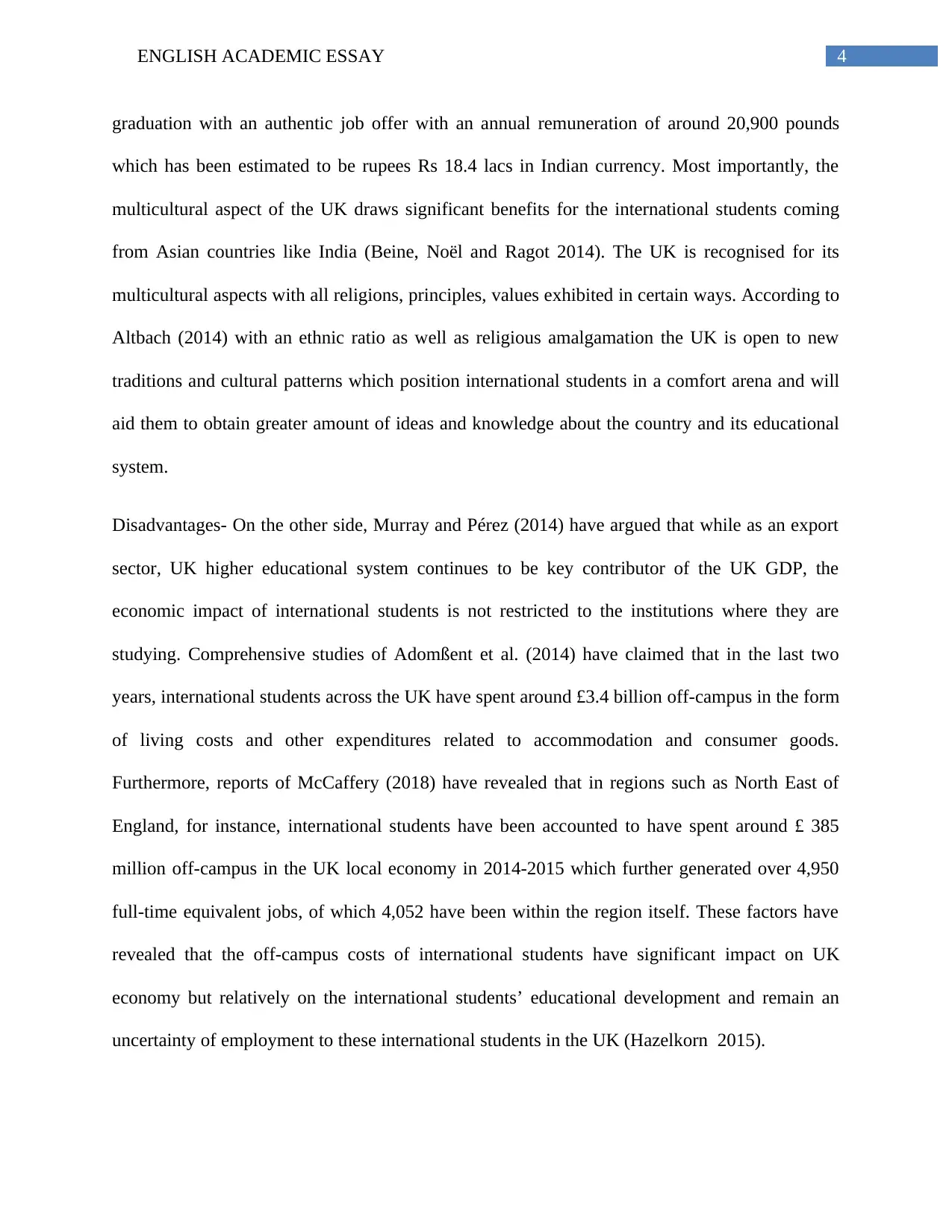
4ENGLISH ACADEMIC ESSAY
graduation with an authentic job offer with an annual remuneration of around 20,900 pounds
which has been estimated to be rupees Rs 18.4 lacs in Indian currency. Most importantly, the
multicultural aspect of the UK draws significant benefits for the international students coming
from Asian countries like India (Beine, Noël and Ragot 2014). The UK is recognised for its
multicultural aspects with all religions, principles, values exhibited in certain ways. According to
Altbach (2014) with an ethnic ratio as well as religious amalgamation the UK is open to new
traditions and cultural patterns which position international students in a comfort arena and will
aid them to obtain greater amount of ideas and knowledge about the country and its educational
system.
Disadvantages- On the other side, Murray and Pérez (2014) have argued that while as an export
sector, UK higher educational system continues to be key contributor of the UK GDP, the
economic impact of international students is not restricted to the institutions where they are
studying. Comprehensive studies of Adomßent et al. (2014) have claimed that in the last two
years, international students across the UK have spent around £3.4 billion off-campus in the form
of living costs and other expenditures related to accommodation and consumer goods.
Furthermore, reports of McCaffery (2018) have revealed that in regions such as North East of
England, for instance, international students have been accounted to have spent around £ 385
million off-campus in the UK local economy in 2014-2015 which further generated over 4,950
full-time equivalent jobs, of which 4,052 have been within the region itself. These factors have
revealed that the off-campus costs of international students have significant impact on UK
economy but relatively on the international students’ educational development and remain an
uncertainty of employment to these international students in the UK (Hazelkorn 2015).
graduation with an authentic job offer with an annual remuneration of around 20,900 pounds
which has been estimated to be rupees Rs 18.4 lacs in Indian currency. Most importantly, the
multicultural aspect of the UK draws significant benefits for the international students coming
from Asian countries like India (Beine, Noël and Ragot 2014). The UK is recognised for its
multicultural aspects with all religions, principles, values exhibited in certain ways. According to
Altbach (2014) with an ethnic ratio as well as religious amalgamation the UK is open to new
traditions and cultural patterns which position international students in a comfort arena and will
aid them to obtain greater amount of ideas and knowledge about the country and its educational
system.
Disadvantages- On the other side, Murray and Pérez (2014) have argued that while as an export
sector, UK higher educational system continues to be key contributor of the UK GDP, the
economic impact of international students is not restricted to the institutions where they are
studying. Comprehensive studies of Adomßent et al. (2014) have claimed that in the last two
years, international students across the UK have spent around £3.4 billion off-campus in the form
of living costs and other expenditures related to accommodation and consumer goods.
Furthermore, reports of McCaffery (2018) have revealed that in regions such as North East of
England, for instance, international students have been accounted to have spent around £ 385
million off-campus in the UK local economy in 2014-2015 which further generated over 4,950
full-time equivalent jobs, of which 4,052 have been within the region itself. These factors have
revealed that the off-campus costs of international students have significant impact on UK
economy but relatively on the international students’ educational development and remain an
uncertainty of employment to these international students in the UK (Hazelkorn 2015).
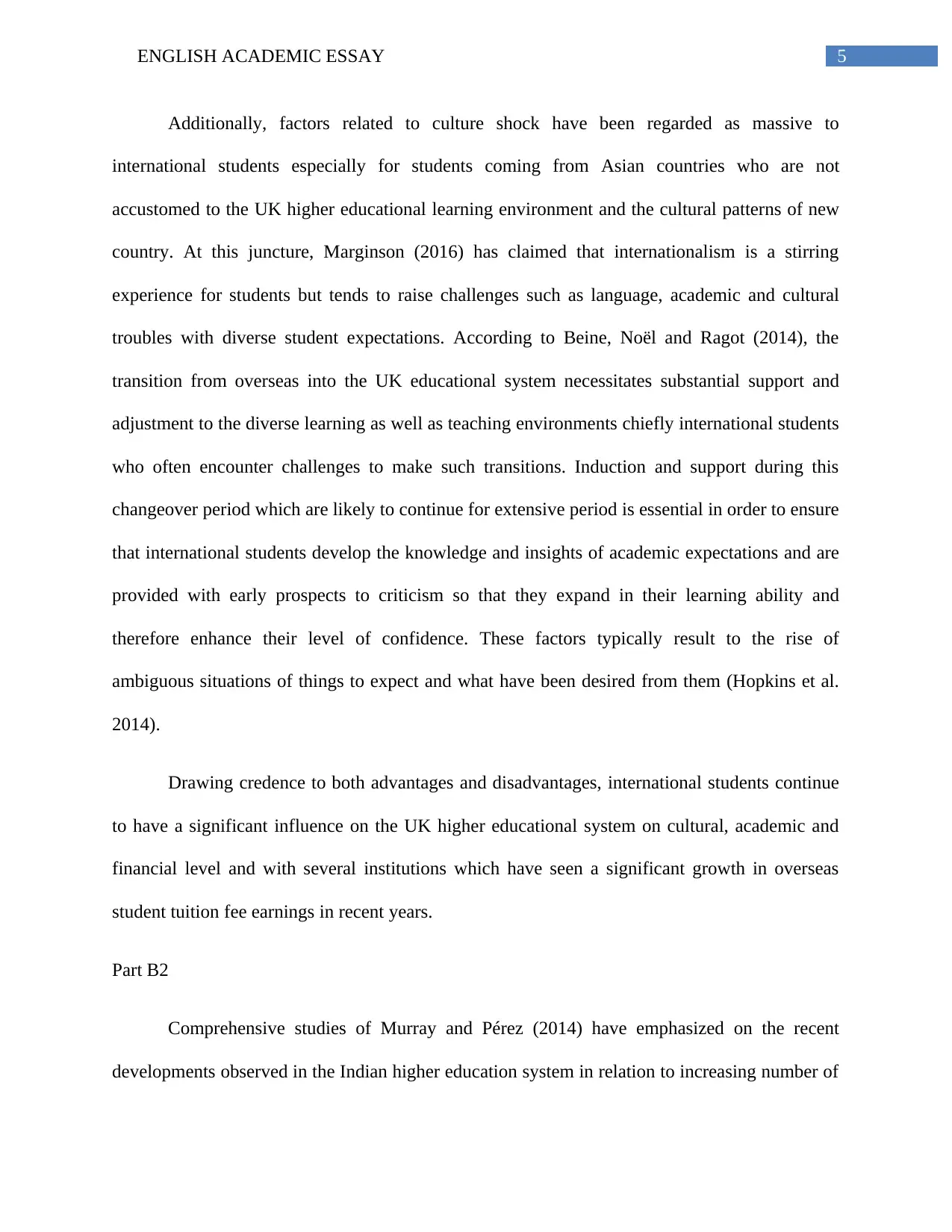
5ENGLISH ACADEMIC ESSAY
Additionally, factors related to culture shock have been regarded as massive to
international students especially for students coming from Asian countries who are not
accustomed to the UK higher educational learning environment and the cultural patterns of new
country. At this juncture, Marginson (2016) has claimed that internationalism is a stirring
experience for students but tends to raise challenges such as language, academic and cultural
troubles with diverse student expectations. According to Beine, Noël and Ragot (2014), the
transition from overseas into the UK educational system necessitates substantial support and
adjustment to the diverse learning as well as teaching environments chiefly international students
who often encounter challenges to make such transitions. Induction and support during this
changeover period which are likely to continue for extensive period is essential in order to ensure
that international students develop the knowledge and insights of academic expectations and are
provided with early prospects to criticism so that they expand in their learning ability and
therefore enhance their level of confidence. These factors typically result to the rise of
ambiguous situations of things to expect and what have been desired from them (Hopkins et al.
2014).
Drawing credence to both advantages and disadvantages, international students continue
to have a significant influence on the UK higher educational system on cultural, academic and
financial level and with several institutions which have seen a significant growth in overseas
student tuition fee earnings in recent years.
Part B2
Comprehensive studies of Murray and Pérez (2014) have emphasized on the recent
developments observed in the Indian higher education system in relation to increasing number of
Additionally, factors related to culture shock have been regarded as massive to
international students especially for students coming from Asian countries who are not
accustomed to the UK higher educational learning environment and the cultural patterns of new
country. At this juncture, Marginson (2016) has claimed that internationalism is a stirring
experience for students but tends to raise challenges such as language, academic and cultural
troubles with diverse student expectations. According to Beine, Noël and Ragot (2014), the
transition from overseas into the UK educational system necessitates substantial support and
adjustment to the diverse learning as well as teaching environments chiefly international students
who often encounter challenges to make such transitions. Induction and support during this
changeover period which are likely to continue for extensive period is essential in order to ensure
that international students develop the knowledge and insights of academic expectations and are
provided with early prospects to criticism so that they expand in their learning ability and
therefore enhance their level of confidence. These factors typically result to the rise of
ambiguous situations of things to expect and what have been desired from them (Hopkins et al.
2014).
Drawing credence to both advantages and disadvantages, international students continue
to have a significant influence on the UK higher educational system on cultural, academic and
financial level and with several institutions which have seen a significant growth in overseas
student tuition fee earnings in recent years.
Part B2
Comprehensive studies of Murray and Pérez (2014) have emphasized on the recent
developments observed in the Indian higher education system in relation to increasing number of
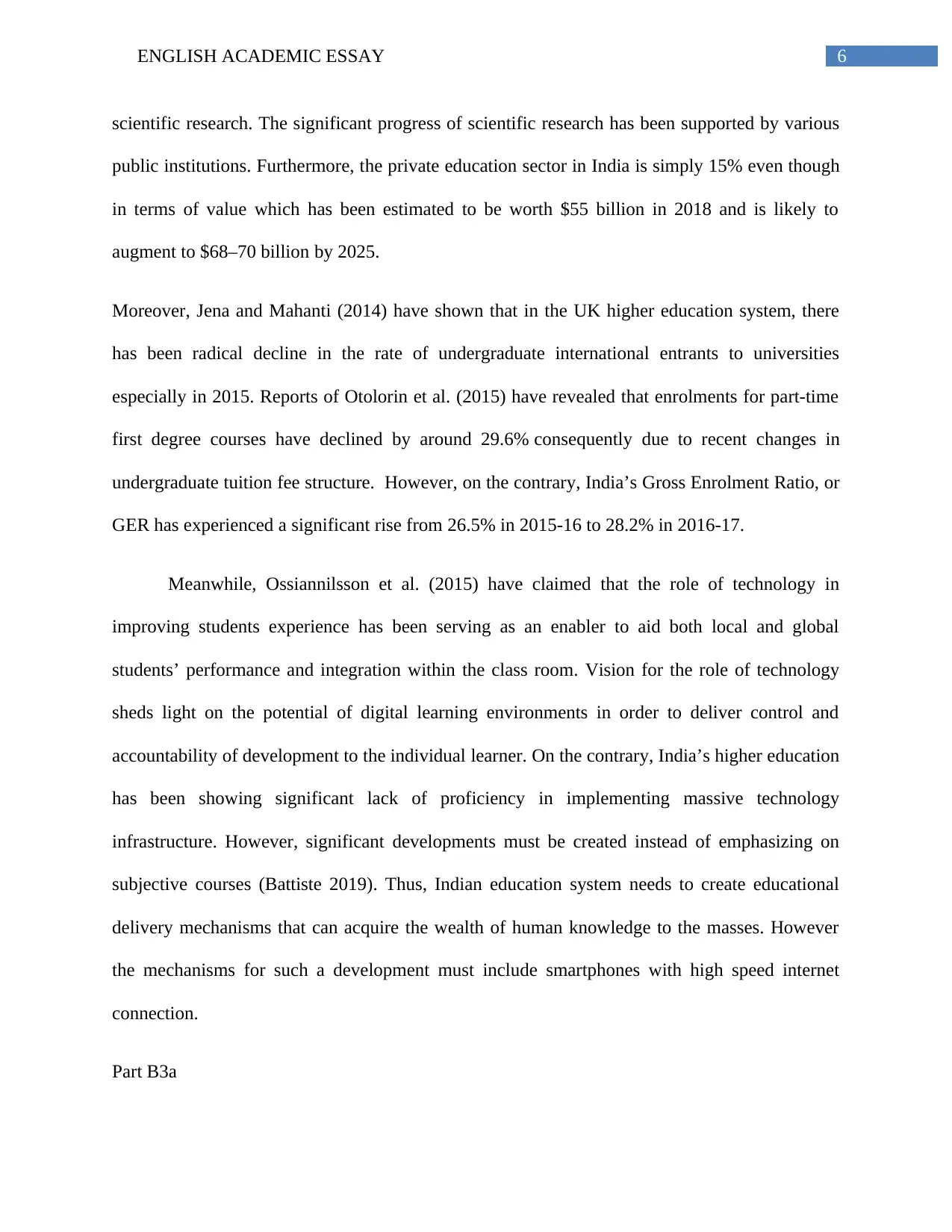
6ENGLISH ACADEMIC ESSAY
scientific research. The significant progress of scientific research has been supported by various
public institutions. Furthermore, the private education sector in India is simply 15% even though
in terms of value which has been estimated to be worth $55 billion in 2018 and is likely to
augment to $68–70 billion by 2025.
Moreover, Jena and Mahanti (2014) have shown that in the UK higher education system, there
has been radical decline in the rate of undergraduate international entrants to universities
especially in 2015. Reports of Otolorin et al. (2015) have revealed that enrolments for part-time
first degree courses have declined by around 29.6% consequently due to recent changes in
undergraduate tuition fee structure. However, on the contrary, India’s Gross Enrolment Ratio, or
GER has experienced a significant rise from 26.5% in 2015-16 to 28.2% in 2016-17.
Meanwhile, Ossiannilsson et al. (2015) have claimed that the role of technology in
improving students experience has been serving as an enabler to aid both local and global
students’ performance and integration within the class room. Vision for the role of technology
sheds light on the potential of digital learning environments in order to deliver control and
accountability of development to the individual learner. On the contrary, India’s higher education
has been showing significant lack of proficiency in implementing massive technology
infrastructure. However, significant developments must be created instead of emphasizing on
subjective courses (Battiste 2019). Thus, Indian education system needs to create educational
delivery mechanisms that can acquire the wealth of human knowledge to the masses. However
the mechanisms for such a development must include smartphones with high speed internet
connection.
Part B3a
scientific research. The significant progress of scientific research has been supported by various
public institutions. Furthermore, the private education sector in India is simply 15% even though
in terms of value which has been estimated to be worth $55 billion in 2018 and is likely to
augment to $68–70 billion by 2025.
Moreover, Jena and Mahanti (2014) have shown that in the UK higher education system, there
has been radical decline in the rate of undergraduate international entrants to universities
especially in 2015. Reports of Otolorin et al. (2015) have revealed that enrolments for part-time
first degree courses have declined by around 29.6% consequently due to recent changes in
undergraduate tuition fee structure. However, on the contrary, India’s Gross Enrolment Ratio, or
GER has experienced a significant rise from 26.5% in 2015-16 to 28.2% in 2016-17.
Meanwhile, Ossiannilsson et al. (2015) have claimed that the role of technology in
improving students experience has been serving as an enabler to aid both local and global
students’ performance and integration within the class room. Vision for the role of technology
sheds light on the potential of digital learning environments in order to deliver control and
accountability of development to the individual learner. On the contrary, India’s higher education
has been showing significant lack of proficiency in implementing massive technology
infrastructure. However, significant developments must be created instead of emphasizing on
subjective courses (Battiste 2019). Thus, Indian education system needs to create educational
delivery mechanisms that can acquire the wealth of human knowledge to the masses. However
the mechanisms for such a development must include smartphones with high speed internet
connection.
Part B3a
Paraphrase This Document
Need a fresh take? Get an instant paraphrase of this document with our AI Paraphraser

7ENGLISH ACADEMIC ESSAY
For India to improve its education system it principally needs to increase its quality of
education by modifying its course and develop infrastructure of local as well as regional
universities by increasing the number of laboratories and improve the proficiencies of teachers to
teach and encourage students (Downey et al. 2017). Furthermore, advanced and innovative
learning approaches in higher education will tend to improve quality in the rapidly evolving
education sector of India. However, the effective ways of achieving these areas is to reinforce the
transformational benefits of cloud, mobile as well as digital technologies in order to enhance
teaching and learning and develop both local as well as international students’ experience.
Communication is considered as another vital area in improving the higher education
efficiency and output. Patil, Nagra and Gopal (2014) have noted that without proper
communication, local and international students and teacher relationship will be troubled and
student will be incompetent of gaining self regulation on their courses.
Part B3b
However, easy accessibility to the teachers can be feasible if been implemented in the
course of discussion forum, conferences, messages and social media platform. These strategies
will efficiently equip students to effectively communicate and disseminate information with
peers.
The next generation educational institutions must efficiently incorporate new curriculum
design and deliverance. Johnson et al. (2016) have noted that using digital technologies will
advance the boundaries of higher education. Furthermore, educators and instructors must capably
adapt to the shifting needs and create classroom sessions more interactive with effortless access
to knowledge.
For India to improve its education system it principally needs to increase its quality of
education by modifying its course and develop infrastructure of local as well as regional
universities by increasing the number of laboratories and improve the proficiencies of teachers to
teach and encourage students (Downey et al. 2017). Furthermore, advanced and innovative
learning approaches in higher education will tend to improve quality in the rapidly evolving
education sector of India. However, the effective ways of achieving these areas is to reinforce the
transformational benefits of cloud, mobile as well as digital technologies in order to enhance
teaching and learning and develop both local as well as international students’ experience.
Communication is considered as another vital area in improving the higher education
efficiency and output. Patil, Nagra and Gopal (2014) have noted that without proper
communication, local and international students and teacher relationship will be troubled and
student will be incompetent of gaining self regulation on their courses.
Part B3b
However, easy accessibility to the teachers can be feasible if been implemented in the
course of discussion forum, conferences, messages and social media platform. These strategies
will efficiently equip students to effectively communicate and disseminate information with
peers.
The next generation educational institutions must efficiently incorporate new curriculum
design and deliverance. Johnson et al. (2016) have noted that using digital technologies will
advance the boundaries of higher education. Furthermore, educators and instructors must capably
adapt to the shifting needs and create classroom sessions more interactive with effortless access
to knowledge.
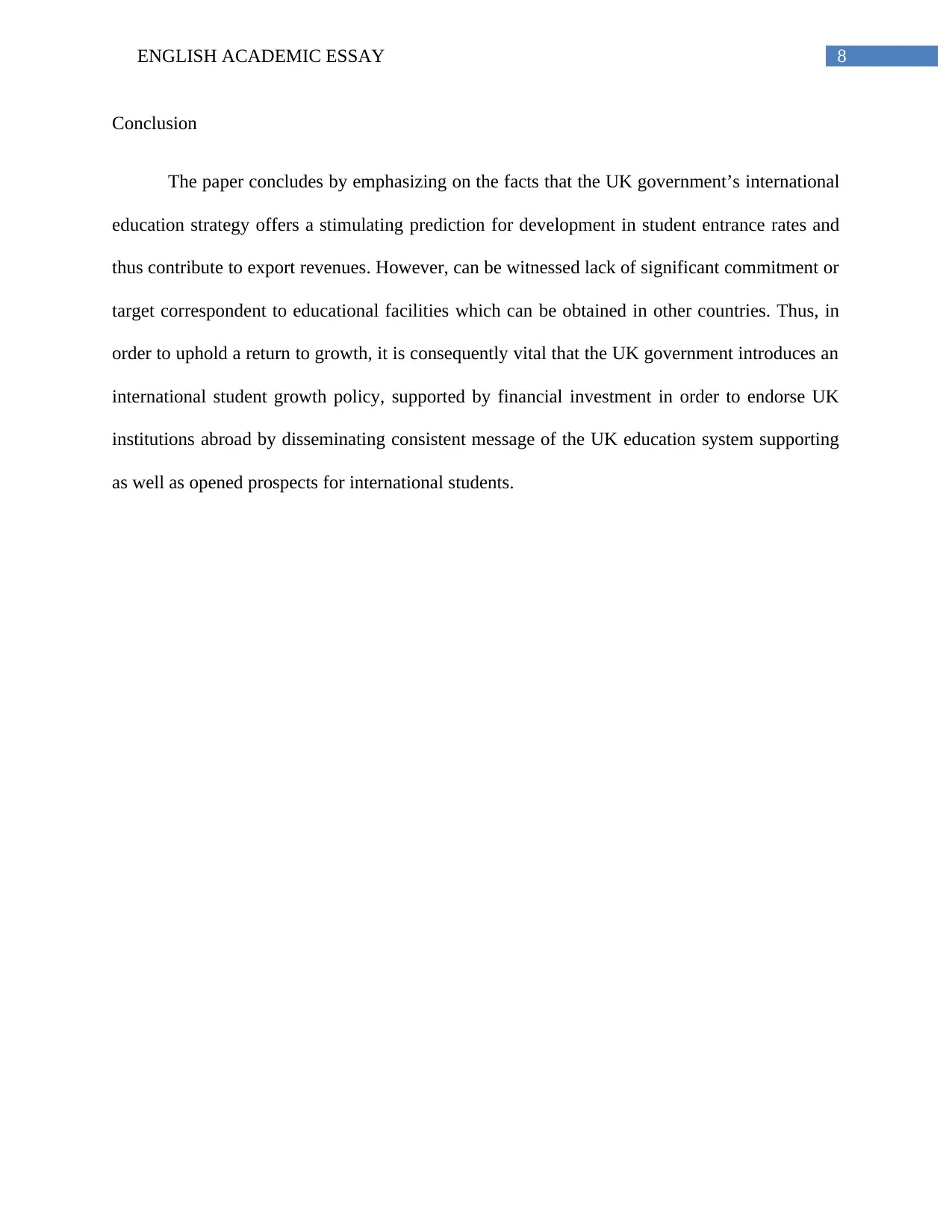
8ENGLISH ACADEMIC ESSAY
Conclusion
The paper concludes by emphasizing on the facts that the UK government’s international
education strategy offers a stimulating prediction for development in student entrance rates and
thus contribute to export revenues. However, can be witnessed lack of significant commitment or
target correspondent to educational facilities which can be obtained in other countries. Thus, in
order to uphold a return to growth, it is consequently vital that the UK government introduces an
international student growth policy, supported by financial investment in order to endorse UK
institutions abroad by disseminating consistent message of the UK education system supporting
as well as opened prospects for international students.
Conclusion
The paper concludes by emphasizing on the facts that the UK government’s international
education strategy offers a stimulating prediction for development in student entrance rates and
thus contribute to export revenues. However, can be witnessed lack of significant commitment or
target correspondent to educational facilities which can be obtained in other countries. Thus, in
order to uphold a return to growth, it is consequently vital that the UK government introduces an
international student growth policy, supported by financial investment in order to endorse UK
institutions abroad by disseminating consistent message of the UK education system supporting
as well as opened prospects for international students.
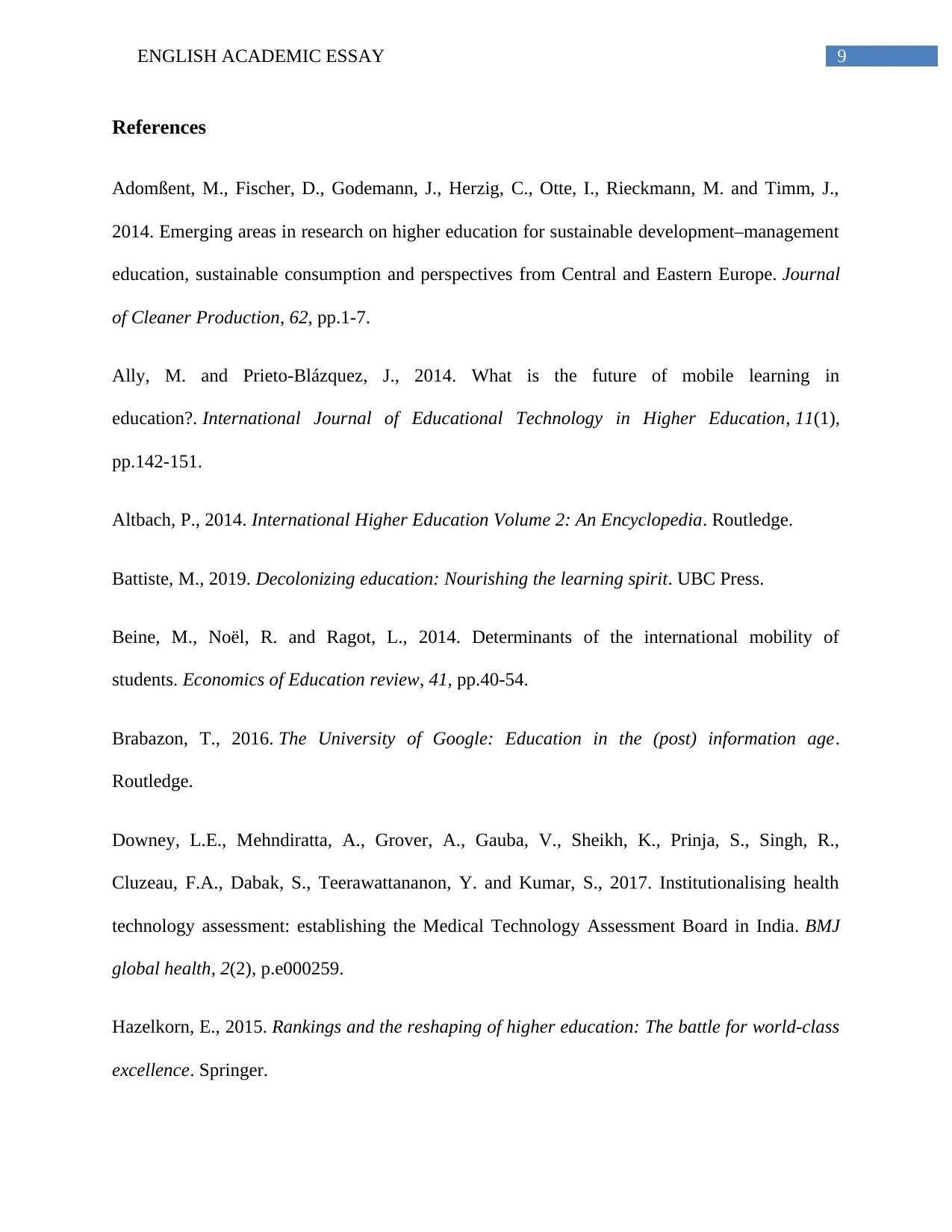
9ENGLISH ACADEMIC ESSAY
References
Adomßent, M., Fischer, D., Godemann, J., Herzig, C., Otte, I., Rieckmann, M. and Timm, J.,
2014. Emerging areas in research on higher education for sustainable development–management
education, sustainable consumption and perspectives from Central and Eastern Europe. Journal
of Cleaner Production, 62, pp.1-7.
Ally, M. and Prieto-Blázquez, J., 2014. What is the future of mobile learning in
education?. International Journal of Educational Technology in Higher Education, 11(1),
pp.142-151.
Altbach, P., 2014. International Higher Education Volume 2: An Encyclopedia. Routledge.
Battiste, M., 2019. Decolonizing education: Nourishing the learning spirit. UBC Press.
Beine, M., Noël, R. and Ragot, L., 2014. Determinants of the international mobility of
students. Economics of Education review, 41, pp.40-54.
Brabazon, T., 2016. The University of Google: Education in the (post) information age.
Routledge.
Downey, L.E., Mehndiratta, A., Grover, A., Gauba, V., Sheikh, K., Prinja, S., Singh, R.,
Cluzeau, F.A., Dabak, S., Teerawattananon, Y. and Kumar, S., 2017. Institutionalising health
technology assessment: establishing the Medical Technology Assessment Board in India. BMJ
global health, 2(2), p.e000259.
Hazelkorn, E., 2015. Rankings and the reshaping of higher education: The battle for world-class
excellence. Springer.
References
Adomßent, M., Fischer, D., Godemann, J., Herzig, C., Otte, I., Rieckmann, M. and Timm, J.,
2014. Emerging areas in research on higher education for sustainable development–management
education, sustainable consumption and perspectives from Central and Eastern Europe. Journal
of Cleaner Production, 62, pp.1-7.
Ally, M. and Prieto-Blázquez, J., 2014. What is the future of mobile learning in
education?. International Journal of Educational Technology in Higher Education, 11(1),
pp.142-151.
Altbach, P., 2014. International Higher Education Volume 2: An Encyclopedia. Routledge.
Battiste, M., 2019. Decolonizing education: Nourishing the learning spirit. UBC Press.
Beine, M., Noël, R. and Ragot, L., 2014. Determinants of the international mobility of
students. Economics of Education review, 41, pp.40-54.
Brabazon, T., 2016. The University of Google: Education in the (post) information age.
Routledge.
Downey, L.E., Mehndiratta, A., Grover, A., Gauba, V., Sheikh, K., Prinja, S., Singh, R.,
Cluzeau, F.A., Dabak, S., Teerawattananon, Y. and Kumar, S., 2017. Institutionalising health
technology assessment: establishing the Medical Technology Assessment Board in India. BMJ
global health, 2(2), p.e000259.
Hazelkorn, E., 2015. Rankings and the reshaping of higher education: The battle for world-class
excellence. Springer.
Secure Best Marks with AI Grader
Need help grading? Try our AI Grader for instant feedback on your assignments.
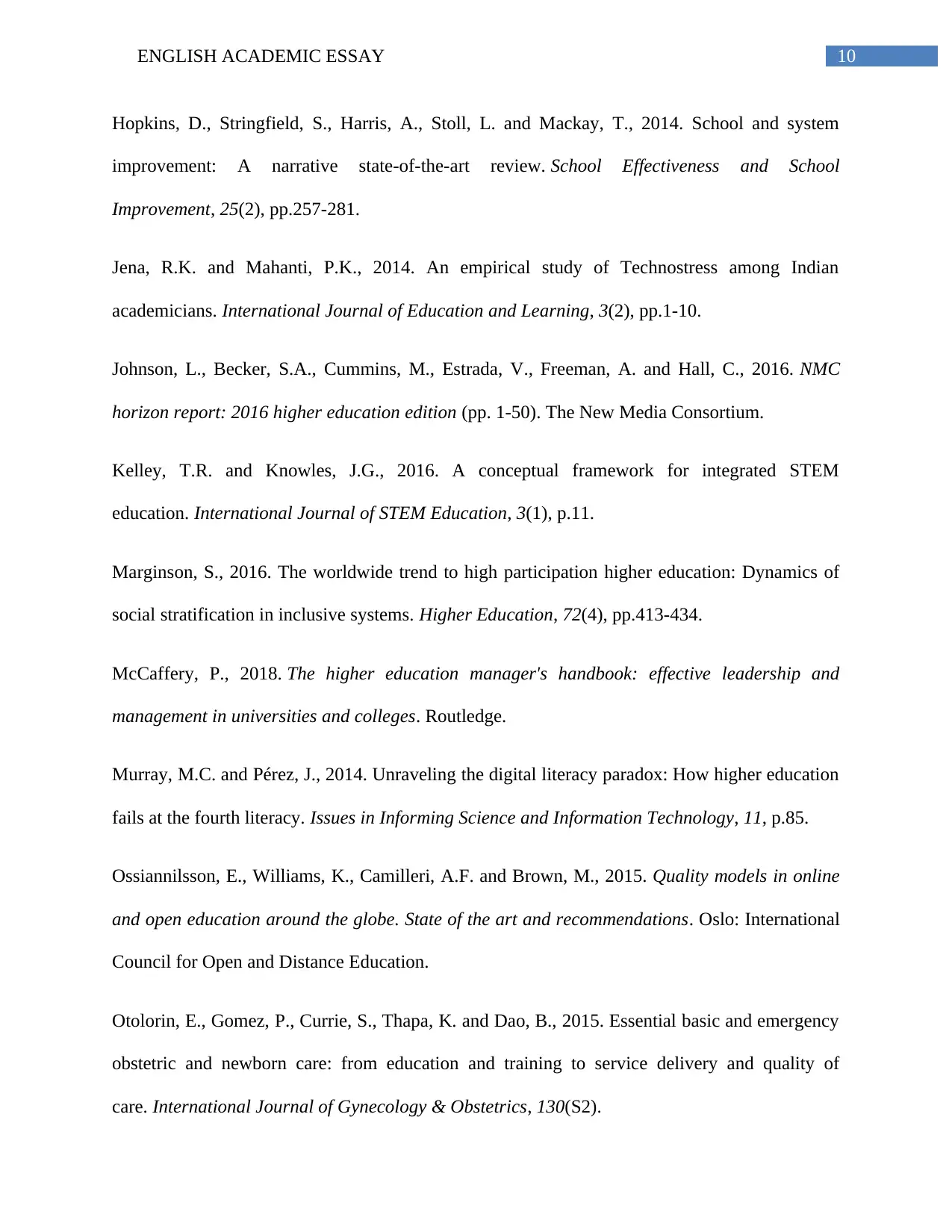
10ENGLISH ACADEMIC ESSAY
Hopkins, D., Stringfield, S., Harris, A., Stoll, L. and Mackay, T., 2014. School and system
improvement: A narrative state-of-the-art review. School Effectiveness and School
Improvement, 25(2), pp.257-281.
Jena, R.K. and Mahanti, P.K., 2014. An empirical study of Technostress among Indian
academicians. International Journal of Education and Learning, 3(2), pp.1-10.
Johnson, L., Becker, S.A., Cummins, M., Estrada, V., Freeman, A. and Hall, C., 2016. NMC
horizon report: 2016 higher education edition (pp. 1-50). The New Media Consortium.
Kelley, T.R. and Knowles, J.G., 2016. A conceptual framework for integrated STEM
education. International Journal of STEM Education, 3(1), p.11.
Marginson, S., 2016. The worldwide trend to high participation higher education: Dynamics of
social stratification in inclusive systems. Higher Education, 72(4), pp.413-434.
McCaffery, P., 2018. The higher education manager's handbook: effective leadership and
management in universities and colleges. Routledge.
Murray, M.C. and Pérez, J., 2014. Unraveling the digital literacy paradox: How higher education
fails at the fourth literacy. Issues in Informing Science and Information Technology, 11, p.85.
Ossiannilsson, E., Williams, K., Camilleri, A.F. and Brown, M., 2015. Quality models in online
and open education around the globe. State of the art and recommendations. Oslo: International
Council for Open and Distance Education.
Otolorin, E., Gomez, P., Currie, S., Thapa, K. and Dao, B., 2015. Essential basic and emergency
obstetric and newborn care: from education and training to service delivery and quality of
care. International Journal of Gynecology & Obstetrics, 130(S2).
Hopkins, D., Stringfield, S., Harris, A., Stoll, L. and Mackay, T., 2014. School and system
improvement: A narrative state-of-the-art review. School Effectiveness and School
Improvement, 25(2), pp.257-281.
Jena, R.K. and Mahanti, P.K., 2014. An empirical study of Technostress among Indian
academicians. International Journal of Education and Learning, 3(2), pp.1-10.
Johnson, L., Becker, S.A., Cummins, M., Estrada, V., Freeman, A. and Hall, C., 2016. NMC
horizon report: 2016 higher education edition (pp. 1-50). The New Media Consortium.
Kelley, T.R. and Knowles, J.G., 2016. A conceptual framework for integrated STEM
education. International Journal of STEM Education, 3(1), p.11.
Marginson, S., 2016. The worldwide trend to high participation higher education: Dynamics of
social stratification in inclusive systems. Higher Education, 72(4), pp.413-434.
McCaffery, P., 2018. The higher education manager's handbook: effective leadership and
management in universities and colleges. Routledge.
Murray, M.C. and Pérez, J., 2014. Unraveling the digital literacy paradox: How higher education
fails at the fourth literacy. Issues in Informing Science and Information Technology, 11, p.85.
Ossiannilsson, E., Williams, K., Camilleri, A.F. and Brown, M., 2015. Quality models in online
and open education around the globe. State of the art and recommendations. Oslo: International
Council for Open and Distance Education.
Otolorin, E., Gomez, P., Currie, S., Thapa, K. and Dao, B., 2015. Essential basic and emergency
obstetric and newborn care: from education and training to service delivery and quality of
care. International Journal of Gynecology & Obstetrics, 130(S2).
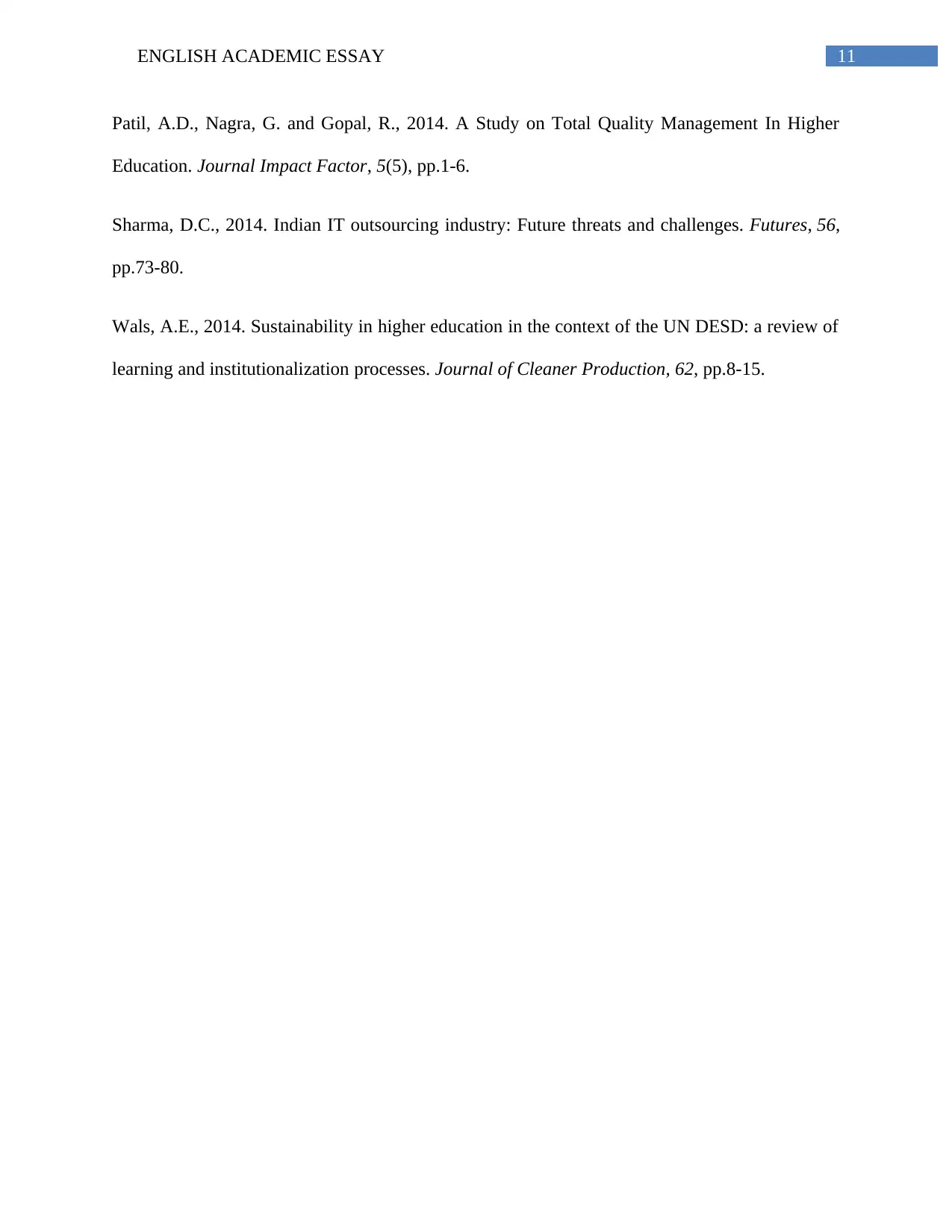
11ENGLISH ACADEMIC ESSAY
Patil, A.D., Nagra, G. and Gopal, R., 2014. A Study on Total Quality Management In Higher
Education. Journal Impact Factor, 5(5), pp.1-6.
Sharma, D.C., 2014. Indian IT outsourcing industry: Future threats and challenges. Futures, 56,
pp.73-80.
Wals, A.E., 2014. Sustainability in higher education in the context of the UN DESD: a review of
learning and institutionalization processes. Journal of Cleaner Production, 62, pp.8-15.
Patil, A.D., Nagra, G. and Gopal, R., 2014. A Study on Total Quality Management In Higher
Education. Journal Impact Factor, 5(5), pp.1-6.
Sharma, D.C., 2014. Indian IT outsourcing industry: Future threats and challenges. Futures, 56,
pp.73-80.
Wals, A.E., 2014. Sustainability in higher education in the context of the UN DESD: a review of
learning and institutionalization processes. Journal of Cleaner Production, 62, pp.8-15.
1 out of 12
Related Documents
Your All-in-One AI-Powered Toolkit for Academic Success.
+13062052269
info@desklib.com
Available 24*7 on WhatsApp / Email
![[object Object]](/_next/static/media/star-bottom.7253800d.svg)
Unlock your academic potential
© 2024 | Zucol Services PVT LTD | All rights reserved.





